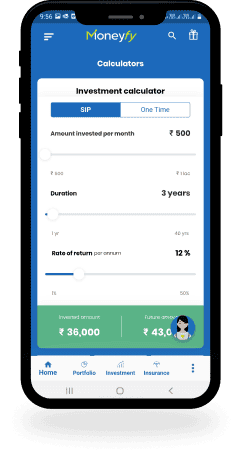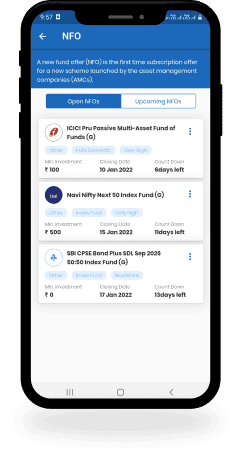What is SIP?
Choose from the
Best SIP plans
Below is a list of the best SIP mutual funds in India. You can make SIP investments in these funds to create the desired corpus for your mid to long-term financial goals.


New to SIPs? We got you!
Understand the basics and benefits of mutual funds to the very minute of details
What is an SIP?
SIP stands for Systematic Investment Plan. It allows you to make disciplined investments in a specific mutual fund scheme by investing fixed amounts at pre-determined intervals, which can be weekly, monthly, quarterly, semi-annually, or annually. Most mutual funds in India allow you to make SIP investments with as low as Rs. 500 per month.
By investing in mutual funds through SIP, you can make recurring investments without worrying about the market dynamics. These investments keep accumulating and, with the power of compounding and rupee cost averaging, snowball into a significant corpus over the long term. To determine the approximate return you can generate through an SIP, you can use an online SIP calculator calculator.
How Does SIP Work?
When you sign up for an SIP investment(s), you allow the Asset Management Company (AMC) to debit a fixed amount from your bank account on a particular date every month. This amount is then automatically invested in the selected mutual fund scheme. Upon successful investment, you are allotted mutual fund units as per their Net Asset Value (NAV) on the investment date.
The NAV per unit of a mutual fund scheme is calculated by dividing the total market value of the securities in which the money has been invested by the total number of active units on the given date. The NAV of a mutual fund scheme keeps fluctuating based on the performance of the underlying assets.
So, every time you invest in SIP, the purchased units are added to your mutual fund account as per the prevailing NAV. During a bullish market, the NAV can be on the higher side, resulting in the purchase of a lesser number of mutual fund units and vice versa. These units accumulate to form a large corpus over the long term.
Let’s understand this through an example. Suppose you’re investing Rs. 10,000 per month in a mutual fund scheme through an SIP. Here’s how you will purchase mutual fund units:
Month |
NAV (in Rs.) |
No. of Units |
First |
50 |
200 |
Second |
52 |
192.30 |
Third |
65 |
153.84 |
Fourth |
51 |
196.07 |
Fifth |
48 |
208.33 |
Sixth |
45 |
222.22 |
So, after six months, you would invest Rs. 60,000 through SIP and purchase 1,172.76 units of mutual funds. Your average cost of purchase would be Rs. (60,000/1172.76), i.e., Rs. 51.16.
Benefits and Features of SIP Investment
Systematic Investment Plan is a popular choice for long-term financial goals among investors. Here are the benefits of investing in the best SIP plan-
- Encourages disciplined saving by allowing regular small investments.
- Reduces market timing risks and minimises the impact of volatility.
- Harnesses the power of compounding, increasing wealth over time.
- Offers flexibility to adjust or stop investments as needed.
- Provides diversification, spreading risk across various assets.
Methods to invest in SIP
There are two ways to invest in mutual funds - the SIP method or the one-time lump sum method. Rookie investors often get confused about whether they should opt for the SIP route or make one-time investments.
SIP method
Investing through the SIP mode has several benefits, as mentioned above. The most notable advantage is that you're not required to time the market. You can invest a fixed amount every month in one of the best SIP plans, and your cost of purchase gets averaged out in the long term. Also, you can start an SIP with as low as Rs. 500 and make recurring investments to create a large corpus for your long-term financial goals.
One-time lump sum method
In this method, you can invest a large amount in a mutual fund upfront. It is a good option if you wish to invest non-recurring income like bonuses or profit from the sale of an asset. However, one-time investments can lead to severe losses during bearish markets. Also, it becomes necessary for the investor to time the market.
How to Invest in SIP through Moneyfy?
Tata Capital's Moneyfy platform allows you to start SIPs in one or more mutual fund schemes of your choice from the convenience of your home or office. You can also compare past performances of various mutual funds and select the best SIP plans to invest in and support your financial goals. Below are the steps you need to follow to start an SIP through Moneyfy:
Step 1 - Visit the Moneyfy website or download the Moneyfy app on your smartphone.
Step 2 - Complete your e-KYC and upload the required documents to open your investor account.
Step 3 - Select the mutual fund scheme in which you want to make SIP investments.
Step 4 - Enter the SIP amount and select the date on which you want to make your investments.
Step 5 - Sign up for an auto-debit mandate to allow the mutual fund company to deduct the SIP amount from your bank account on the selected date every month.
What are the Documents Required for SIP Investment?
You must submit or upload specific documents to open your investor account with Moneyfy and start an SIP in the desired mutual fund scheme. The list of documents you need to submit is as follows:
KYC Documents - PAN Card and Aadhaar Card
Canceled cheque
A valid address proof such as an Aadhaar Card, Driving License, Voter ID Card, or utility bills
Please note that this list is indicative, and you may require some additional documents to open your account. The activation of your investor account is subject to successful verification of your documents.
Why Choose SIP Investment Plan
Systematic Investment Plan (SIP) is a disciplined investment approach that helps in building wealth corpus for future by investing a pre determined sum at regular intervals.
- Builds a savings habit over time
- Invest in New Funds Offer (NFOs) from various AMCs
- Hassle-free, automated investments
- Grow wealth faster with compounding
- Balances risk during market ups and downs
FAQs on SIP
VIEW ALLWhat is an SIP Account?
An SIP account helps you invest fixed amounts in a mutual fund scheme at a fixed date every month. Having an SIP account allows you to make disciplined investments for your long-term financial goals. You can open an SIP account with the help of a mutual fund distributor or directly with the fund house.
Which SIP is Best?
To understand which SIP is the best for you, you will need to know your income flow. If you are a salaried employee, monthly SIP is the best option for you. The frequency of investment depends on your investment needs and your income flow.
What are the types of SIP plans?
Types of SIP plans include Regular SIP, which allows fixed monthly investments; Flexible SIP, which adjusts the investment amount based on market conditions; and Top-up SIP, which enables investors to increase their monthly contributions periodically.
What is the minimum amount to invest in SIP?
The minimum investment amount for SIPs varies by mutual fund house, but you can typically start with as little as Rs. 500 per month. There is no maximum limit on the investment amount.
What is NAV in SIP?
The NAV in SIP stands for "Net Asset Value". It is the price at which an investor can sell or purchase their mutual fund units at a given point in time. Every time you invest in SIP, a certain number of mutual fund units get purchased as per their current NAV.
What is SIP Top-up?
The SIP top-up facility allows you to increase your monthly SIP amount at pre-determined dates. This facility helps you automatically increase your SIP investments to ensure that you stay ahead of inflation.
Which SIP is Best?
To understand which SIP is the best for you, you will need to know your income flow. If you are a salaried employee, monthly SIP is the best option for you. The frequency of investment depends on your investment needs and your income flow.
Which SIP is best for 1 year?
It is advisable to invest in SIPs for the long term. However, if you want to invest for just 1 year, you can consider short-term debt mutual funds or liquid funds to get better returns than savings accounts.
Which SIP is best for 10 years?
For a long-term SIP, best plans include equity mutual funds like Nifty 50 index funds, flexi-cap, or large-cap funds. Make sure to select the fund carefully based on its past performance and expense ratios.
Should I invest a lump sum or SIP?
The best option between SIP and lump sum depends on your investment style and preference. SIPs are usually better for rupee cost averaging and reducing market volatility risk.
Should I start SIP when the market is high?
Yes, SIPs help you average out the costs over time. So, even if you invest when the market is high, regular investments can help you benefit from market corrections in the long run.
Is SIP good for the long term?
Yes, SIP is a good option for long-term wealth creation. It lets you benefit from the power of compounding, reduces the risk of market volatility, and helps build financial discipline.
What is the average return in SIP?
The average return of an SIP depends on the fund you've selected. It also varies based on the market performance and investment horizon. Equity SIPs typically offer 10-12% returns, while debt SIPs can return anywhere around 6-8% annually.
How long can we invest in SIP?
You can easily invest in SIP through Tata Capital Moneyfy. All you need to do is create an account, compare your options, and start investing.
How Much Should I Invest in SIP?
To determine how much you should invest in SIP, you will need to assess your income and investment goals. Once you know how much corpus you need to create and in how much time, you can calculate the approximate amount that you should invest every month to create that much corpus.
Track your SIP investment amount
You can get your SIP statement online by visiting the Tata Capital Moneyfy website and logging into your investor account. There is also a portfolio section on the Moneyfy app to track your cumulative investments through SIP and my transaction section to track the status of all your transactions.
How to Calculate Tax on SIP?
Tax on SIP is calculated only at the time of redemption, and it depends upon the type of mutual fund and the duration for which they are held by the investor. If the SIP is for equity mutual funds, Short-Term Capital Gains (STCG) tax at a 15% rate is applicable if they are redeemed within 12 months. If the funds are held for more than 12 months and the gains exceed Rs. 1 lakh, Long-Term Capital Gains (LTCG) tax at a 10% rate without indexation is applicable.
Can I buy a SIP plan online?
You can start investing in a specific mutual fund through Tata Capital Moneyfy. To set up an SIP-
Log on to the app using your MPIN.
Complete your KYC.
Select your desired fund.
Select the fund and set up the SIP investment by specifying the amount and the date.
How to Withdraw the SIP Amount Online?
To withdraw your SIP amount online, log into your investor account and place the redemption request.
How to Stop SIP Online?
You can also stop your SIP online through Tata Capital's Moneyfy platform. However, it's never advisable to stop your SIP unless there is an emergency.
What happens if we cancel SIP?
If you cancel an SIP, your future contributions will stop. However, your existing units will remain invested and continue to earn returns.




















